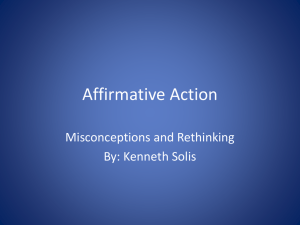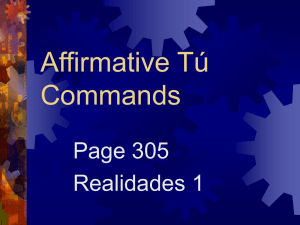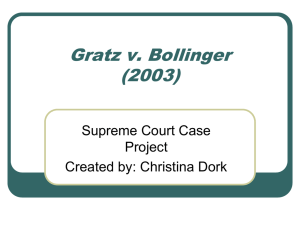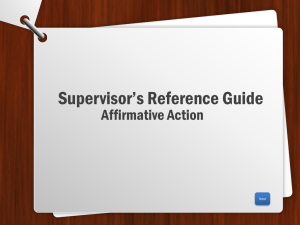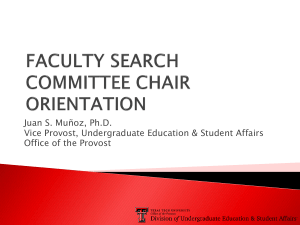Search Committee Resources - University of Pennsylvania
advertisement
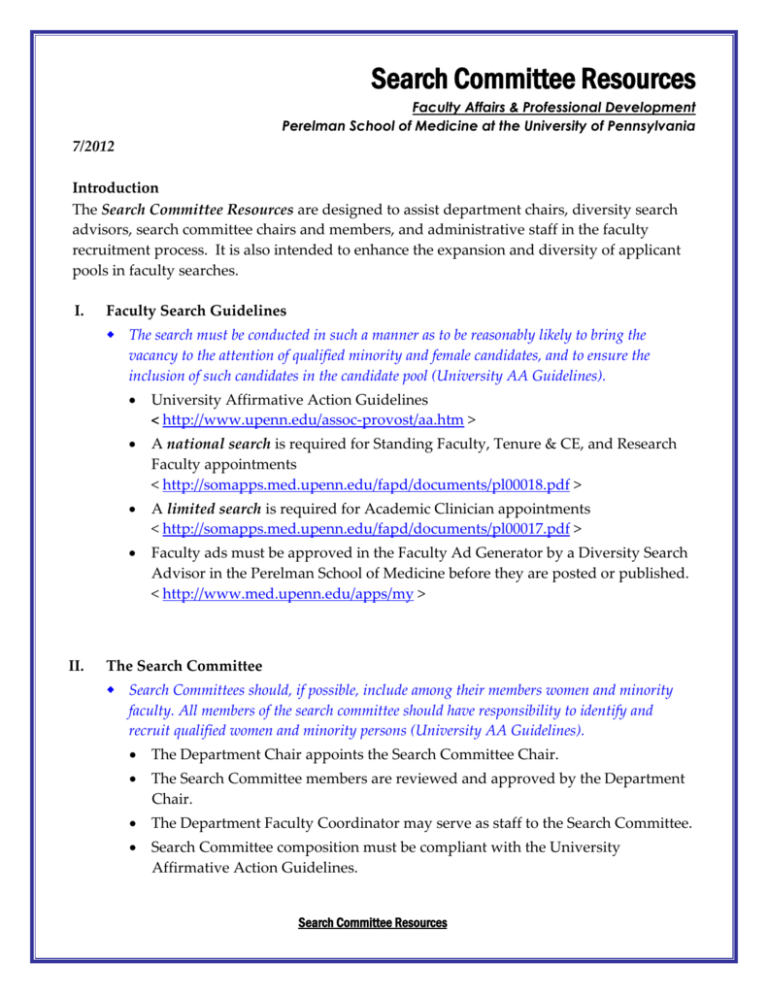
Search Committee Resources Faculty Affairs & Professional Development Perelman School of Medicine at the University of Pennsylvania 7/2012 Introduction The Search Committee Resources are designed to assist department chairs, diversity search advisors, search committee chairs and members, and administrative staff in the faculty recruitment process. It is also intended to enhance the expansion and diversity of applicant pools in faculty searches. I. Faculty Search Guidelines The search must be conducted in such a manner as to be reasonably likely to bring the vacancy to the attention of qualified minority and female candidates, and to ensure the inclusion of such candidates in the candidate pool (University AA Guidelines). II. University Affirmative Action Guidelines < http://www.upenn.edu/assoc-provost/aa.htm > A national search is required for Standing Faculty, Tenure & CE, and Research Faculty appointments < http://somapps.med.upenn.edu/fapd/documents/pl00018.pdf > A limited search is required for Academic Clinician appointments < http://somapps.med.upenn.edu/fapd/documents/pl00017.pdf > Faculty ads must be approved in the Faculty Ad Generator by a Diversity Search Advisor in the Perelman School of Medicine before they are posted or published. < http://www.med.upenn.edu/apps/my > The Search Committee Search Committees should, if possible, include among their members women and minority faculty. All members of the search committee should have responsibility to identify and recruit qualified women and minority persons (University AA Guidelines). The Department Chair appoints the Search Committee Chair. The Search Committee members are reviewed and approved by the Department Chair. The Department Faculty Coordinator may serve as staff to the Search Committee. Search Committee composition must be compliant with the University Affirmative Action Guidelines. Search Committee Resources III. The Search Committee Chair gives a final Search Committee Report to the Department Chair and the Faculty Coordinator to process the recruitment and appointment of the selected candidate. Diversity Search Advisor Description of the role and responsibilities of the diversity search advisor http://somapps.med.upenn.edu/fapd/documents/ext00214.doc IV. Diversity and Outreach in Searches Unconscious Bias E-Learning Seminar-- "What You Don't Know: The Science of Unconscious Bias and What To Do About it in the Search and Recruitment Process" -- American Association of Medical Colleges (AAMC) < http://www.aamc.org/opi/leadership/training.htm > Unconscious Bias in Faculty and Leadership Recruitment < https://www.aamc.org/download/102364/data/aibvol9no2.pdf > V. VI. Faculty Opportunity Fund -- Provost’s fund for faculty recruitment, retention and enhancement of faculty diversity. Contact FAPD for submission process. < http://somapps.med.upenn.edu/fapd/documents/ext00048.pdf > Dual Recruitment Program – Provost’s fund for support to departments for a position for the spouse or partner of a desired recruit. Contact FAPD for submission process. < http://www.upenn.edu/provost/images/uploads/Dual.Career_.Funding_.10_.pdf Search Checklists Advertising and Search Committee Candidate Evaluation Form Faculty Search Ads Contact Penn’s strategic provider for assistance in placing faculty recruitment advertisements. < http://cms.business-services.upenn.edu/publications/media-placement.html > Search Committee Resources 2 VII. Outreach for Faculty Candidates General Resources CareerConnect - American Association of Medical Colleges (AAMC) –Reach highquality candidates and an alliance with the National Healthcare Career Network (NHCN). 1) Post to CareerConnect or 2) Post to NHCN and position will be automatically distributed to all relevant association job boards in the network. < https://www.aamc.org/services/careerconnect/ > Chronicle of Higher Education < http://chronicle.com/section/Jobs/61/ > Higher Education Recruitment Consortium (HERC) < http://www.hercjobs.org/site/793/jobs.cfm?site_id=793 > Inside Higher Ed – FREE posting for University of Pennsylvania Faculty Ads < http://www.insidehighered.com/ > National Conferences – Attach documentation of conferences attended to recruit faculty candidates to the Affirmative Action (AA) Appointment Form For Women AMA Women Physician Specialty Groups < http://www.ama-assn.org/ama/pub/about-ama/our-people/member-groupssections/women-physicians-congress/specialty-groups.shtml > American Medical Women’s Association < http://www.amwa-doc.org/career/ > Association of Black Women Physicians < http://www.blackwomenphysicians.org/index.php > Association for Women in Science < http://www.awis.org/jobbank.cfm > ELAM - Executive Leadership in Academic Medicine Program for Women <http://www.drexelmed.edu/Home/OtherPrograms/ExecutiveLeadershipinAcade micMedicine/JobPostings.aspx > Women in Cancer Research – American Association for Cancer Research (AACR) < http://www.aacr.org/home/membership-/association-groups/women-in-cancerresearch.aspx > For Minorities AMA Resources for Minorities < http://www.ama-assn.org/ama/pub/about-ama/our-people/member-groupssections/minority-affairs-consortium/helpful-links.shtml > Search Committee Resources 3 Annual Biomedical Research for Minority Scientists (ABRCMS) –Annual Conference < http://www.abrcms.org/index.html > Compact for Faculty Diversity - focuses on minority graduate education and faculty diversity- FREE Job posting < http://www.instituteonteachingandmentoring.org/Compact/index.html > Diverse -- Issues in Higher Education < http://diversejobs.net/ > Harvard Diversity Inclusion and Community Partnership – Programs for Fellows and Junior Faculty <http://www.mfdp.med.harvard.edu/fellows_faculty/cfhuf/fellows/bios/index.ht ml > Historically Black Colleges, Universities And Medical Schools < http://www2.ed.gov/about/inits/list/whhbcu/edlite-list.html > INSIGHT Into Diversity (formerly Affirmative Action Register) < http://www.insightintodiversity.com/ > IMDiversity < http://www.imdiversity.com/ > MinorityPostdoc.org < http://www.minoritypostdoc.org/view/jobs.html > National Medical Association -- Annual Conference and Career Center/Job Postings < http://www.nmanet.org/ > Society for the Advancement of Chicanos and Native Americans in Science (SACNAS)-- Annual Conference and Job Postings < http://www.sacnas.org/jobIndex.cfm > Directories – These are searchable databases for women and minority candidates Directory of Ford Foundation Fellows -- Ford Foundation Diversity Fellowships, administered by NRC of the National Academies. Access to database is free. <http://nrc58.nas.edu/FordFellowDirect/Main/Main.aspx > Future Black Faculty Database (FBF)-- Database developed at UC Berkeley which contains records of doctoral candidates and graduates, of African-American descent seeking tenure-track university faculty positions. Access to database is free. <http://bgess.berkeley.edu/faculty/> Minority and Women Doctoral Directory -- A resource for universities seeking to recruit women and minority Ph.D.s. into their faculties. The current edition lists approximately 4,500 minority and women students. See website for cost. < http://www.mwdd.com/ > Search Committee Resources 4 VIII. Additional Resources for Faculty Searches IX. ADVANCE Program at the University of Michigan < http://www.umich.edu/%7Eadvproj/handbook.pdf > Guide to Recruiting and Retaining an Excellent and Diverse Faculty at Stanford University < http://www.stanford.edu/dept/provost/diversity.pdf > Searching for Excellence and Diversity: A Guide for Faculty Search Committee Chairs at University of Wisconsin-Madison < http://wiseli.engr.wisc.edu/docs/SearchBook.pdf > Faculty Applicants Apply Online Open Faculty Positions in the Perelman School of Medicine < http://www.med.upenn.edu/apps/faculty_ad/ > X. Recruitment Worksheet for Candidates—Download from Faculty Ad Applicant Review section in My.Med < http://www.med.upenn.edu/apps/my/ > Faculty Candidate Interviews - Video Conferencing Skype - Talk face-to-face with live video for FREE to interview faculty candidates < http://www.skype.com > Penn Medicine Media Technology and Production < http://www.med.upenn.edu/mtp/videoconferencing.html > Penn Videoconferencing Services < http://www.upenn.edu/video/pvp/services_vcon.html > CONTACTS < http://www.upenn.edu/video/pvp/contact.html > XI. New and Prospective Faculty “What Every Faculty Member Should Know” – This is a starting point for new and prospective faculty to understand a faculty appointment at the Perelman School of Medicine. < http://www.med.upenn.edu/facaffairscurriculum/orientation/ > XII. Penn Medicine Professional Onboarding Services for Faculty Candidates Provides customized, one-on-one services for new faculty in order to ensure their transition to Penn Medicine is seamless. < www.pennmedicine.org/professional-onboarding-services > Intake Form – to request Penn Medicine Professional Onboarding Services http://somapps.med.upenn.edu/fapd/documents/ext00094.pdf Search Committee Resources 5 Faculty Search Guidelines National Search Limited Search Faculty Ad Affirmative Action in School of Medicine Searches University Affirmative Action Guidelines Search Committee Resources NATIONAL SEARCH For New Appointments Standing Faculty, Tenure and CE, and Research Track 1. Department initiates a formal search process a. Advertise position(s) A national search is required for all new Standing Faculty, Tenure and CE, and Research Track faculty appointments. o The search process must include every effort to enhance the recruitment of women and underrepresented minorities and to ensure the inclusion of such candidates in the candidate pool. Approved positions must be advertised in accordance with the Affirmative Action guidelines and procedures of the University and the Perelman School of Medicine. The text of the advertisement must be pre-approved by a Diversity Search Advisor using the PSOM Faculty Ad Generator online application < www.med.upenn.edu/apps/my/fapd > The faculty ad is posted on the Faculty Affairs & Professional Development website < http://www.med.upenn.edu/apps/jobpostings/public/ > Advertisements must be placed in a minimum of 2 professional journals (the journals may be either on-line or hard copy publications) A formal national direct search letter from the department chair/search committee must be sent to universities, schools, and departments Advertisement must be listed for at least three (3) months before effective appointment date Advertisements and search letters are valid for up to 2 years b) Establish a formal search committee for each position Membership of the search committee must be appointed by the department chair. The search committee will include senior faculty from the home department (one should be a member of the departmental COAP) and in the instance of Tenure Track candidates, and Clinician Educator and Research Track candidates at the Associate Professor or Professor level one or more PSOM senior faculty with primary appointments outside of the home department. o Search committees should, if possible, include among their members women and minority faculty. All members of the search committee should have responsibility to identify and recruit qualified women and minority persons. c) Completed AA Appointment Form (BLUE) is required Source: University Affirmative Action Guidelines Revised 7-2012 7 LIMITED SEARCH For New Appointments Academic Clinician Track 2. Department initiates a formal search process o Advertise position(s) A limited search is required for all new Academic Clinician appointments. o The search process must include every effort to enhance the recruitment of women and underrepresented minorities and to ensure the inclusion of such candidates in the candidate pool. Approved positions must be advertised in accordance with the Affirmative Action guidelines and procedures of the University and the Perelman School of Medicine. The text of the advertisement must be pre-approved by a Diversity Search Advisor using the PSOM Faculty Ad Generator online application < www.med.upenn.edu/apps/my/fapd > The faculty ad for Academic Clinician will be posted in two (2) locations: 1) Posting of the faculty ad on the Faculty Affairs & Professional Development website < http://www.med.upenn.edu/apps/jobpostings/public/ > 2) The faculty ad is posted in another source which may include professional journals, on-line advertising, or websites of professional organizations. Advertisement must be posted for at least one (1) month before effective appointment date in both locations. c) Establish a formal search committee for each position The search committee will include three (3) faculty members from the home department, and may include faculty from other departments. o Search committees should, if possible, include among their members women and minority faculty. All members of the search committee should have responsibility to identify and recruit qualified women and minority persons. 2) Completed AA Appointment Form (BLUE) is required Source: University Affirmative Action Guidelines Revised 7-2012 8 -- SAMPLE -FACULTY AD on FAPD Ad Generator Assistant Professor CE Track - Cornea & Refractive Surgery Recruiting Organization: Ophthalmology Posting Department: Ophthalmology State: posted Posted Date: 07/09/2012 Expire Date: 07/09/2014 OFFICIAL AD TEXT: The Department of Ophthalmology at the Perelman School of Medicine at the University of Pennsylvania seeks candidates for an Assistant Professor position in the non-tenure clinician-educator track. The successful applicant will have experience in the field of Ophthalmology with a focus on Cornea and Refractive Surgery. Responsibilities include attending in resident clinic and operating room and teaching medical students and residents. Qualified individuals will be involved in independent or collaborative research in areas relevant to basic and/or clinical and/or educational ophthalmology. Applicants must have an M.D or M.D./Ph.D. degree and have demonstrated excellent qualifications in education, research, and clinical care. A three year residency in Ophthalmology, and a one year fellowship in Cornea and Refractive surgery is required. Experience with corneal basic science research, especially corneal stem cell research is preferred. We seek candidates who embrace and reflect diversity in the broadest sense. The University of Pennsylvania is an equal opportunity, affirmative action employer. Apply for this position online at: http://www.med.upenn.edu/apps/faculty_ad/index.php/g327/d2986 WARNING: Faculty ads must be published in professional journals in the exact wording and format as approved by the AA Officer to meet the University AA Guidelines 9 Perelman School of Medicine Searches at the University of Pennsylvania Demonstrating Affirmative Action: Basic Elements of a Job Search (Prepared by Janice Bellace, former Deputy Provost of the University, October 2004) Federal employment law requires that employers maintain processes in hiring that ensure equal opportunity. Over the years, both federal regulations and case law have set out the basic principle; namely, that persons qualified for a job should have an opportunity to apply for it. To do this, they must know of the job opening and they must have an understanding of the job’s requirements such that they realize they are capable of performing the job. Federal law also requires that employers consider all qualified applicants. Numerous cases have explored the adequacy of the employer’s defense when an employer has been charged with employment discrimination in hiring. In most cases, the employer argues that it selected the best person for the job. To prove this defense, an employer must show: 1) what are the critical elements of the job; 2) what requirements (e.g., degrees, training, experience) relate to successful performance of the job, and; 3) how candidates were evaluated. Penn’s processes are meant to implement federal law. The Affirmative Action form completed at the end of the faculty search process is designed to document certain aspects of the job search. First, the faculty position must be advertised in a professional journal or an online bulletin board widely consulted by those in the field. The department must also send a search letter or e-mail to department chairs at other schools, heads of research programs, etc. in the same field to alert them of the opening. The idea is to cast the net widely. Second, the faculty position must be described in a way that qualified candidates would have a fair understanding of what the job entails. Thus a generic advertisement for “assistant professors, associate professors, and professors” in “surgery” is too broad. All one can tell from this is that the department of surgery is hiring, but it is not clear for what job. Clear and specific requirements are fine. It is appropriate to state what training or experience is required. If those making the decision know they will give preference to certain factors, the ad can state this (e.g., “Preference will be given to candidates who can demonstrate ….”). Because of the long lead times in print journals, it may be that a generic ad in such a journal is necessary, but if so, it should include the URL for the website where interested persons can find more detailed information about specific job openings. However, a job description for a faculty position should not be written to fit a particular person such that it is highly unlikely that any other person could match the job description. The job description is meant to describe the job that needs to be done, not the person whom the department wants to hire. Third, the description of the job for the faculty position should be the basis for the initial evaluation of the applicants. If the job description did not state any requirement or preference for training in a specific area, then candidates without such training should not be ruled out. There should be a formal search committee, with due regard given to gender and other diversity concerns. 10 Affirmative Action in School of Medicine Searches Demonstrating Affirmative Action: Basic Elements of a Job Search Search committees should, if possible, include among their members women and minority faculty. All members of the search committee should have responsibility to identify and recruit qualified women and minority persons (from University AA Guidelines, Jan 2003). Fourth, a reasonable number of persons who appear to be qualified on paper must be interviewed. To avoid the burden and expense of unnecessary interviews, methods of contact other than face-toface interviews can be utilized. For instance, at the first stage, a search committee might engage in an initial screening of candidates by scheduling telephone interviews. Telephone interviews can be used to get more information, to get some idea of the candidate’s interests and to give more information about the position than can be contained in an ad. The next step that might be used is a video conference or webcam interview. When the short list of candidates is narrowed down to a manageable number, then face-to-face interviews should be used. It would be the unusual situation where only one candidate was invited for a face-to-face interview. [If this occurs, there would have to be an explanation attached of why no one else was interviewed.] Fifth, if the successful candidate is internal, the department /search committee chair must attach an explanation of the factors that were applied to all candidates, and why this candidate was deemed to be superior on those measures. Case law over the years has demonstrated that judges are suspicious of internal candidates being selected. Plaintiffs typically will argue that the “old boy network” favored its own and that there was not a true, open competition for the job. Thus, it is important for the search committee chair to explain the nature of the “open competition” so that we can be confident that the best person was selected. Note: The University of Pennsylvania’s Affirmative Action form is used by all 12 schools. Faculty searches in the School of Medicine are often very different from those in the other 11 schools. As such, the way questions are asked, or the spaces provided for answers may not be entirely suitable for departments in the SOM. In responding to question III.3 on the AA Form, the department /search committee chair is encouraged to submit an additional sheet that explains more fully the factors taken into consideration by those making the decision (that is, the reasons why you concluded that this is the best candidate, not just a flat statement of the conclusion that this is the best candidate). Additional documentation can be submitted to demonstrate the breadth of the search. For instance, a copy of an e-mail sent to department chairs at other schools, with a list of the recipients, can be attached. 11 Office of the Associate Provost University of Pennsylvania Affirmative Action Guidelines and Procedures For Faculty Appointments, Promotions and Terminations http://www.upenn.edu/assoc-provost/aa.htm I. UNIVERSITY POLICY ON EQUAL OPPORTUNITY II. AFFIRMATIVE ACTION ADMINISTRATION AT THE UNIVERSITY Executive Director of the Office of Affirmative Action and Equal Opportunity Programs Associate Provost Executive Assistant to the Associate Provost School Affirmative Action Officers President’s Affirmative Action Council III. PROCEDURES New Appointment IV. INSTRUCTIONS FOR USE OF THE COMPLIANCE FORMS Racial/Ethnic Categories Required Documentation Color-coded Forms Specific Instructions for Each of the Three Forms 1. New Appointment I. UNIVERSITY POLICY ON EQUAL OPPORTUNITY "The University of Pennsylvania does not discriminate on the basis of race, sex, sexual orientation, religion, color, national or ethnic origin, age, disability, or status as a Vietnam Era Veteran or disabled veteran in the administration of educational policies, programs or activities; admissions policies; scholarship and loan awards; athletic, or other University administered programs or employment." In each case (new appointment, reappointment, promotion and termination), the selection will be made in accordance with the University's policy on equal opportunity. In all appointment, reappointment and promotion actions, the best candidate will be selected. II. AFFIRMATIVE ACTION ADMINISTRATION OF THE UNIVERSITY OF PENNSYLVANIA A. EXECUTIVE DIRECTOR OF THE OFFICE OF AFFIRMATIVE ACTION AND EQUAL OPPORTUNITY PROGRAMS Ultimate responsibility for the University's affirmative action program rests with the Trustees and the President. However, the Executive Director of the Office of Affirmative Action and Equal Opportunity Programs (OAA/EOP) has been designated as the executive responsible for coordinating the University's equal opportunity programs. With the advice of the Executive Director of OAA/EOP, the Associate Provost makes and officially promulgates affirmative action policies for the academic staff. The responsibilities of the Executive Director of OAA/EOP also include orientation for Staff Affirmative Action Compliance Officers and participation with the Executive Assistant to the Associate Provost in orientation for Faculty Affirmative Action Officers. The Executive Director advises the Provost’s office concerning Schools and Academic Divisions, as outlined in the annual Affirmative Action plan update, where mathematical under utilization of women and/or minorities exists, and concerning mechanisms for "special 12 effort searches". Also the Executive Director has principal oversight responsibility for the auditing and reporting systems under the University's affirmative action program. B. ASSOCIATE PROVOST Working in close cooperation with the Executive Director of OAA/EOP and the School Affirmative Action Officers, the Associate Provost has primary responsibility for affirmative action/equal opportunity programs for the faculty. C. EXECUTIVE ASSISTANT TO THE ASSOCIATE PROVOST The Executive Assistant to the Associate Provost has primary responsibility for day- to-day administration of affirmative action/equal opportunity programs for the faculty. She/he participates with the Associate Provost and the Executive Director of OAA/EOP in orientation for Faculty Affirmative Action Officers. She/he arranges for meetings of the School Affirmative Action Officers at least once a year for discussion of problems and exchange of information. D. SCHOOL AFFIRMATIVE ACTION OFFICERS In each of the University's twelve Schools, one or more Affirmative Action Officer is selected by the Dean to monitor equal opportunity compliance in the faculty appointment and promotion process within the School. These officers are tenured or senior clinician-educator faculty member(s) who hold no administrative position. Each fall the Dean will forward the name(s) of the School Affirmative Action Officer(s) to the Associate Provost by September 15. The Affirmative Action Officer(s) may be given released time from some other duties in order to serve in this capacity. The Affirmative Action Officer's responsibilities include: providing affirmative action/equal opportunity information to Department Chairs, the Chairs of search committees, and individual faculty members; consulting at a very early stage in the process with search committees and Department Chairs on affirmative action/equal opportunity policies, the placement and wording of advertisements, the wording of letters soliciting candidates and requesting evaluations, special efforts to contact women's and minority organizations; reviewing all faculty equal opportunity compliance forms for the School; periodically reviewing availability data with the Deans and Department chairs. in the faculty appointment and promotion process, substantive decisions on academic merit and staffing needs are the responsibility of the faculty of the appointing Department, the School personnel committee, the Deans and the Provost. If the affirmative action officer perceives a problem with the procedures proposed for a faculty search or in reviewing the equal opportunity compliance form and accompanying documentation, the officer should first attempt to address these issues with the participating faculty members. If, after consulting with the participating faculty members, the affirmative action officer continues to believe that an issue exists, the affirmative action officer shall notify the Department Chair or the Dean immediately. If the problem is not resolved readily by the provision of further documentation or explanations on the part of the Department Chair, the Dean should mediate and assist in the matter and the problem should be brought to the attention of the Associate Provost. E. PRESIDENT’S AFFIRMATIVE ACTION COUNCIL The Affirmative Action Council is a presidential committee charged with reviewing the University's equal opportunity and affirmative action policies and recommending changes. It also conveys concerns and issues raised in the University community regarding equal opportunity and affirmative action issues to the President. In addition, it monitors the University's programs and performance in meeting its affirmative 13 action/equal opportunity objectives. In particular it reviews this document every fourth year and makes suggestions for improving the processes here contained. The results of Council's deliberations, conclusions and recommendations are included in its annual report to the President. III. PROCEDURES A. NEW APPOINTMENT 1. Formal searches are required for: • all new appointments in the Standing Faculty and the Standing Faculty Clinician-Educator • all new appointments in the research track of the Associated Faculty, and • all new appointments as full time clinical faculty in the Associated Faculty of the Dental School. The University of Pennsylvania is dedicated to an organizational strategy that supports the full realization of equal employment opportunity for all. Before the new or vacant faculty position may be filled, a search must be made to generate the broadest and strongest possible candidate pool. The search must be conducted in such a manner as to be reasonably likely to bring the vacancy to the attention of qualified minority and female candidates, and to ensure the inclusion of such candidates in the candidate pool. Searches based on "informal contacts" are unacceptable. Separate searches must be conducted for positions in different subfields. Before initiating a search, Chairs should consult with the School Affirmative Action Officer with respect to the conduct of the search generally. When possible, the Affirmative Action Officer should be invited to the first meeting of the search committee to describe affirmative action procedures and to discuss ways of increasing the numbers of qualified women and minorities in the pool. The School Affirmative Action Officer must be informed of openings as they occur and must be given a draft copy of the advertisement announcing the position for review and approval prior to its submission for publication. The advertisement should specify the subfield if appropriate, desired qualifications, and the faculty rank and track. The advertisement must include the sentence: "The University of Pennsylvania is an equal opportunity affirmative action employer; women and minority candidates are strongly encouraged to apply." The position should be advertised for a reasonable length of time in professional journals, and, where possible, caucus newsletters likely to reach minority and women scholars. Normally advertisements will specify a faculty rank and/or whether the position is to carry tenure; exceptions can be made only if a broader search represents a special effort to increase the number of minority and women applicants. An appointment should never be based upon a search that was made two years or more in the past. Search committees should, if possible, include among their members women and minority faculty. All members of the search committee should have responsibility to identify and recruit qualified women and minority persons. An expanded search network should include direct letters to graduate Departments. Disciplinary and professional associations, including committees and caucus groups, should be contacted and their facilities for employee location and referral used. Where possible, placement of on-line postings are encouraged to supplement other methods of advertising. Each School and Department should know the general proportion of women and minority groups within the national pool of candidates for particular academic positions, and should make diligent 14 efforts to bring women and minority group candidates into serious consideration for available positions. To ensure accuracy and consistency, please consult scholarly organizations as well as the following University of Pennsylvania offices for availability data: Office of Institutional Research for the Fall AA report OAA/EOP for availability figures and goals. The School’s Affirmative Action Compliance Officer shall have access to dossiers of all women and minority candidates. In cases where a "short list" of candidates is constructed, the Affirmative Action Officer should have access to that list also. The University will not honor any offers, formal or informal, which are made before Provost's approval. This is only given when proper affirmative action material has been approved at the Provost's level and the appointment has been approved by the Provost’s Staff Conference. Any offers that are made before Provost's approval must be conditioned upon these approvals. Cases where a formal search was not conducted at the time of the candidate's initial appointment at the University must be handled as new appointments (requiring a search), and not as promotions. For instance, if a person who is currently a research associate or research specialist at the University is to be recommended for an appointment as research assistant professor, a search must be documented. Similarly, if the pool for appointment of assistant professors in clinical Departments is considered to be primarily medical residents in the clinical specialty at Penn, it must be demonstrated that the group of medical residents was chosen using a national search procedure that was not biased against minorities or women. "Special effort searches" may be required where a Department or School is under-utilizing women or minorities. The mechanism for special effort searches is set up by the appropriate Dean. Target of Opportunity: In rare and exceptional instances it is possible to make an appointment without a search. This exception is possible only when a person of unquestioned preeminence becomes available and the University can justify the appointment. A formal written request for a waiver of a search must be submitted by the Department Chair to the Office of the Associate Provost. This request must include detailed documentation supporting the request, and the candidate's current curriculum vitae. Written approval of the waiver of the search will be forwarded to the Department Chair. Copies of both the request and the approval of the waiver of the search must be included in the Affirmative Action Faculty Compliance form. 2. In the selection process, serious consideration must be given to qualified women and members of minority groups. The best candidate from the pool will be selected. 3. Departments are required to retain written records of data concerning candidates, and of all applications and supplementary material received from applicants for all full-time and part-time faculty posts, for two years after a position has been filled. This applies to records of both successful and unsuccessful applicants. 4. The blue “Faculty Equal Opportunity Compliance Statement” for new appointments can be found at : https://www.med.upenn.edu/apps/my/fapd/apps/fads?_preserve[show]=y&start_mod=2&start_panel=3 15 Diversity and Outreach in Searches Best Practices for Faculty Recruitment and Orientation Faculty Opportunity Fund 16 Top Ten BEST PRACTICES Faculty Recruitment and Orientation Perelman School of Medicine at the University of Pennsylvania PREPARING TO SEARCH - Recognize the value of increased gender and racial diversity in the department and realize that it requires will, the desire for change, and action to achieve this diversity. 1. Utilize faculty networks to expand the applicant pool. Develop model of a recruitment steering committee to proactively identify and target faculty candidates to recruit for department programs. Faculty are encouraged to utilize word-of-mouth with colleagues regardless of field or discipline to disseminate information about faculty positions at Penn and the institution to attract faculty candidates. Circulate information about open faculty positions to all faculty in department. Contact former faculty and residents about open faculty positions to expand and diversify applicant pools. Make personal contacts with potential faculty candidates. Involve faculty members who have membership in minority and women’s organizations to make contacts for potential qualified minority and women faculty candidates. Create increased awareness about minority medical schools and universities where higher percentages of minorities are completing postgraduate degrees to reach out to qualified minority applicants for faculty positions. Involve faculty members who have contacts at these schools. 2. Invite diverse external speakers to consider as potential faculty candidates. In the process of selecting speakers for seminars and grand rounds, extend an invitation to speakers with diverse perspectives and backgrounds as a way to evaluate and expand the pool of potential applicants for faculty positions. 3. Involve department faculty coordinator in faculty searches. The faculty coordinator would provide Search Committee Resources to department search committees, assist with outreach to minority and women applicants and ensure follow-up with candidates throughout the search process. EXTENDING YOUR REACH – Go beyond the status quo and the “usual and customary” to recruit more diverse faculty candidates. Using only the minimum required recruitment techniques will not result in a newly diverse pool of faculty candidates. 4. Create awareness of unconscious bias in faculty searches. 17 The Unconscious Bias Presentation for department faculty and search committee members will increase awareness for creating a supportive environment to attract diverse faculty candidates. 5. Enhance Search Committee diversity. The initial meeting of the search committee is the most important for impact in reviewing candidates. Contact and involve Affirmative Action Officers as resources for the Search Committee. Utilize faculty from other departments to diversify Search Committees with minority and women members. In addition, different specialties will diversify perspectives. Include both junior and senior faculty members on Search Committees. Senior women faculty who have volunteered to be members of search committees should be contacted. 6. Ensure professional attention and respect for every faculty candidate. Ensure that every candidate who is interviewed on campus is respected and treated well during their visit. Provide the opportunity for women and minority faculty candidates to meet with other women and minority faculty at Penn. Senior women faculty who have volunteered to meet and greet faculty recruitment candidates should be contacted. Departments are encouraged to arrange comprehensive tours for faculty candidates, including the department, School, University campus and Philadelphia area. In addition, in a relocation situation, include the spouse/partner in these tours. This would promote a more supportive and collegial environment to attract candidates to Penn. ORIENTING AND DEVELOPING NEW FACULTY – Respect possible differences in new women and minority faculty members’ backgrounds and life experiences and realize that faculty development and retention requires more than “one size fits all.” 7. Create welcoming environment for new faculty. Ensure that new faculty attend the New Faculty Reception hosted by the Dean. Department staff should inform new junior faculty members about one-on-one orientation meetings with the Associate Director of Faculty Professional Development. Departments are encouraged to assist new faculty in setting up meetings with School /University personnel and departments that support research related services for faculty. Faculty are encouraged to develop faculty gatherings outside of formal, business faculty meetings to address issues unique to women and minority faculty for mentoring, career development and networking in a new environment. 8. Mentor faculty for academic advancement and success. A mentoring committee model or multiple mentors in departments would promote a higher level of attention to the importance of mentoring for junior faculty and provides a variety of people available for mentoring. 18 Senior faculty members in departments are encouraged to be involved with junior faculty members to dialogue about their mentoring needs and requirements. Faculty Affairs and Professional Development (FAPD) will provide contacts with senior minority and women members available as mentors if new faculty members request. 9. Promote professional development of faculty. Department staff are encouraged to distribute information about Advance to faculty and inform them about workshops to attend that will support their academic development as faculty. 10. Leadership in departments that is committed to faculty diversity makes a difference. 19 FACULTY OPPORTUNITY FUND REQUEST Information about Proposed Faculty Member/Existing Faculty Member We are requesting University assistance for a(n): _ __ potential faculty recruit _____ current faculty member (please check one) Name of the person we are attempting to recruit/retain:_______________________ Department:____________________________________________________________ Current or proposed rank and title:________________________________________ Proposed academic base salary:___________________________ Incremental increase in academic base salary for faculty member being retained: _________________________________ ________ Anticipated appointment date of recruited faculty (if applicable):_______________ Other Information Please attach resume/CV of the faculty member being recruited/retained. On a separate sheet, please provide a brief statement of the reason(s) for the request. In particular, describe how the qualifications and strengths of the faculty member will enhance the academic excellence, breadth, and diversity of the faculty, including any other considerations relevant to the mission of the University. Approval of Chair/Associate Dean ______________________________________________________________ Signature of Department Chair/Associate Dean Date Approval of Dean ______________________________________________________________ Signature of Dean Date For Internal Use _____________________________________________________________ 20 Signature of Associate Provost, Faculty Affairs Date (Attach memo if necessary) _____________________________________________________________ Signature of Executive Director of Administrative Affairs Date _____________________________________________________________ Signature of Provost Date 21 MEMORANDUM TO: Council of Deans FROM: Ronald J. Daniels DATE: May 3, 2006 RE: Faculty Opportunity Fund Following up on our discussions regarding faculty recruitment and retention and enhancing faculty diversity, I want to advise you of a new fund, the Faculty Opportunity Fund, which will replace and expand upon the Gender Equity Recruitment and Retention Fund and the Reinvestment Fund (formerly the Minority Faculty Recruitment and Retention Fund). The purpose of the Faculty Opportunity Fund will be to enhance the academic strength and diversity of the faculty in a number of dimensions including, for example, the intellectual, geographic, gender, racial and cultural interests and backgrounds of the faculty. This Fund is reserved for candidates who, in the dean’s opinion, will make extraordinary scholarly contributions and add a distinctive strength to the overall. The Fund will support up to fifty percent of the salary and benefits for faculty members in the first year of his or her appointment, followed by up to twenty-five percent support in the second year. Comparable levels of support will be provided for retention efforts, but need not be spent exclusively on salary and benefits. Requests for recruitment or retention efforts are for appointments to the standing faculty in either the CE track or tenure track. Requests for funding support should be addressed to my office and should include the proposed salary or retention package, the level of support requested, and a copy of the candidate’s CV. I encourage you to make use of the Fund to attract and retain outstanding faculty who will enhance the diversity on our campus. cc: Amy Gutmann Search Committee Resources Search Checklists Advertising Checklist Search Committee Checklist Candidate Evaluation Form 23 ADVERTISING CHECKLIST Perelman School of Medicine at the University of Pennsylvania Proposed Faculty Position: Rank/Track ________________________________________________________________ Proposed Appointment Date ____________________________________________________ Department/Division:__________________________________________________________ Search Committee Chair:_______________________________________________________ Faculty Search Initiation ________ Consult with Department Chair regarding recruitment needs ________ Position included in annual departmental budget report, which must be approved by the SOM. ________ Forward faculty ad to Faculty Coordinator ________ Ad approval by SOM Affirmative Action Officer in the Faculty Ad Generator Note: Search Committee should be formed by this time. ________ Faculty ad must be published in a minimum of two (2) professional journals, either hard copy of online. Names of journals/on line sites noted below: 1. _______________________________________ 2. _______________________________________ 3. _______________________________________ 4. _______________________________________ ________ _________ _________ ________ Have you contacted professional women and minority organizations for the recruitment advertisement? Have you contacted women and minority scholars in your department/discipline to assist in developing candidate pool? Formal national search letter from the Search Committee must be sent to universities, schools, departments, graduate groups and minority/women’s organizations. A faculty ad must be published at least three (3) months before the effective appointment date, and is valid for two (2) years. To be submitted by the Search Committee Chair to the Faculty Coordinator: (The following documents are forwarded to the Faculty Coordinator) ________ Copies of all published ads, including the journal cover and publication date. If posted online, a copy of the on-line ad. Ads must include dates of publication and journal titles. ________ Copy of one search letter (sample letter) ________ Copy of mailing list for search letter – list should include women and minority organizations ________ Copy of the letter forwarded to the minority /women’s organization (s) 24 SEARCH COMMITTEE CHECKLIST Perelman School of Medicine at the University of Pennsylvania Proposed Faculty Position (Rank/Track):___________________________________________________ Proposed Appointment Date :____________________________________________________________ Department /Division ___________________________________________________________________ Search Committee Chair:________________________________________________________________ Search Committee Members – Forward list to Department Chair ________ Search Committee membership should include: One (1) senior faculty member from the Departmental COAP & one (1) SOM senior faculty member w/primary appt outside the department. ________ The Search Committee will include among their members women & underrepresented minority persons. One member of the Search Committee should be given special responsibility to identify and recruit qualified women & underrepresented minority persons. The Search Committee list should include: name, department, rank & track of members. Department Chair has authority to approve or disapprove any member of the search committee. Reviewing Faculty Applicants and Candidates ________ The Recruitment Worksheet should be used continuously throughout the search process to track all applicants. ________ Candidate CVs forwarded to Search Committee members ________ Candidate Evaluation form forwarded to Search Committee members _______ Each interviewer will submit to the Search Committee Chair a written Candidate Evaluation Form of each candidate’s qualifications and thematic fit. After the most qualified candidate has been chosen, the Search Committee Chair will forward the following to the Department Chair: ________ Search Committee Summary Report -- Should include Search Committee members, where/when advertised, number of applicants, those invited for interviews, if position was offered to another applicant w/reason he/she didn't accept position, steps taken to attract women/minorities, why selected candidate was chosen, etc. ________ Affirmative Action Appointment Form – Is designed to document the faculty search process and should be prepared as early as possible for submission to the School Affirmative Action Officer. 1)_______ CVs of all applicants for the position. 2) _______ If the candidate is neither minority nor female, submit the dossiers (curriculum vitae and recommendation letters, if any) of the two (2) most qualified members of minority groups and the two (2) most qualified women considered. 3) _______ If the applicant pool was less than five (5), provide an explanation for the small pool. If you interviewed only one (1) candidate, please provide an explanation. If the selected candidate is internal, please provide justification for recommending an internal hire. Explain how he/she is more qualified than every other candidate who applied. Additionally, if the faculty candidate has been an Instructor, Lecturer, or Research Associate (Academic Support Staff), you must submit a letter that outlines what the person has been doing in the position compared to the new responsibilities in the proposed faculty position. 25 CANDIDATE EVALUATION FORM Perelman School of Medicine at the University of Pennsylvania Candidate Name Proposed Position Department Identify sources of information for this evaluation: curriculum vitae in person meeting observed teaching attended research presentation observed clinical care read research reports or publications research co-investigator read letters of recommendation other, please list Rate from 1 to 5 (5 is the highest ) Comments Clinical skills Research skills Research productivity – impact of publications Research funding Potential for research collaboration Teaching skills Experience in leadership positions Educational background and academic career Fit with department’s needs and mission Interpersonal skills Other Comments Pertinent to Position: Name of Evaluator ____________________________________________ _______________ Search Committee Resources Date Search Committee Resources
